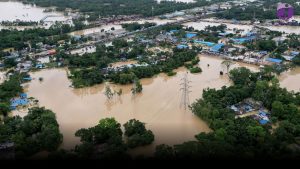The Ganges, recognized as India’s longest and most sacred river, is a habitat for thousands of dolphins, but their survival is threatened.
However, these differ from those typically discovered in oceans. They do not exhibit dramatic leaps from the water, remain at the surface for extended periods, or swim in a vertical posture. In a surprising adaptation, these creatures swim sideways and spend a significant portion of their time submerged. Characterized by their elongated snouts, they are also nearly blind.
Gangetic dolphins, recognized as India’s national aquatic animal, inhabit primarily the Ganges-Brahmaputra river system in the country’s northern region.
A recent survey reveals that India’s rivers are home to approximately 6,327 river dolphins, comprising 6,324 Gangetic dolphins and a mere three Indus dolphins. The Indus dolphins predominantly inhabit the waters of Pakistan, as the river traverses both nations in South Asia.
The International Union for Conservation of Nature (IUCN) has classified both dolphin species as “endangered.”
In a groundbreaking study, researchers from the Wildlife Institute of India surveyed 58 rivers in 10 states from 2021 to 2023, culminating in India’s first comprehensive count of river dolphins.
The origins of river dolphins present a captivating narrative that mirrors the creatures’ intrigue. Scientists describe them as “living fossils,” noting their evolution from marine ancestors millions of years ago.
As the sea inundated the low-lying regions of South Asia, these dolphins ventured inland. Remarkably, they chose to remain in their new habitat when the waters eventually receded. As time progressed, these creatures adjusted to the conditions of murky, shallow rivers, evolving characteristics that distinguished them from their relatives inhabiting the ocean.
According to specialists, the recent survey plays a vital role in monitoring the populations of river dolphins. Since 1980, a minimum of 500 dolphins have perished, with many falling victim to accidental entanglement in fishing nets or being killed intentionally, underscoring the persistent dangers facing the species.
Conservationist Ravindra Kumar Sinha highlights that before the early 2000s, awareness regarding river dolphins was notably scarce.
In 2009, the Gangetic River dolphin was officially designated India’s national aquatic animal to enhance conservation efforts. Initiatives such as a 2020 action plan and establishing a dedicated research center in 2024 have contributed to its resurgence in numbers.
Despite progress, conservationists assert that significant challenges remain ahead.
Dolphins remain targets for poaching, as their flesh and blubber are harvested for oil, which is then utilized as fishing bait. They sometimes encounter collisions with boats or become ensnared in fishing lines, leading to fatal outcomes.
Nachiket Kelkar, representing the Wildlife Conservation Trust, informed Sanctuary Asia magazine that numerous fishermen frequently refrain from reporting accidental dolphin deaths due to concerns about potential legal repercussions.
By Indian wildlife legislation, both accidental and intentional killings of dolphins are classified as “hunting,” which is subject to severe penalties. Consequently, numerous impoverished fishermen discreetly discard the carcasses to evade penalties.
The rise of river cruise tourism in India over the past decade has posed additional threats to the local habitat. Numerous cruise trips are currently being made along the Ganges and Brahmaputra rivers.
Conservationist Ravindra Kumar Sinha expressed concern over the potential impact of cruise disturbances on dolphins, emphasizing their sensitivity to noise in a statement to The Guardian newspaper.
Mr. Sinha warns that the rise in vessel traffic may lead to the extinction of Gangetic dolphins, drawing parallels to the fate of Baiji dolphins in China’s Yangtze River.
River dolphins encounter challenges that can be attributed, in part, to their evolutionary development. With limited vision, they depend on echolocation, utilizing high-pitched sound pulses that reflect off surrounding objects and return as echoes to maneuver through the murky waters. This characteristic aligns with their natural environment and exposes them to contemporary dangers.
River dolphins face significant risks due to their limited vision and sluggish swimming abilities, which increase their vulnerability to collisions with boats and various obstacles in their environment. Their vulnerability is further exacerbated by a slow reproductive cycle, with maturation occurring between six and ten years of age. Female individuals typically give birth to only one calf every two to three years.
Mr. Sinha expresses optimism regarding the future of river dolphins in India. Government initiatives have significantly contributed to their preservation. “Significant progress has been made, yet there is still much work ahead,” he states.













